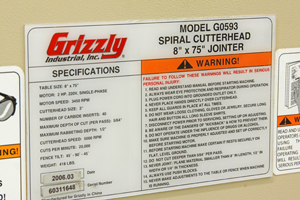
I’ve been a fan of the Woodworker’s Journal eZine for years and really value your knowledge. I will be purchasing a jointer for my small shop and am not sure whether to get a 6″ or 8″. The price difference is $400, but that I can handle. Is there a significant advantage of one over the other? – Rusty Aurand
Rob Johnstone: In addition to straightening edges and squaring them to faces, one important task for the jointer is flattening one face of a board before you put it through a planer. The 8-inch planer will flatten a wider board than the 6-inch. In my opinion, you will never regret choosing the 8-inch jointer over the 6-inch, so for my money … the 8-inch is the way to go. (But of course we are talking about your money … not mine!)
Tim Inman: I think the operative part of your question centers around the “small shop” issue. I have an antique cast-iron Crescent brand 8-inch jointer. It came from the Beloit Wagon Works in Beloit, Wisconsin. It has two low-angled cutting blades and the cutterhead runs (ever so smoothly!) in Babbitt bearings. It was designed for use with flat belting, but I’ve converted it to modern V-belts. It is a monster, but I love it. I include this information with my answer to simply say that, in my experience with woodworking machines, bigger and heavier is almost always better. That said, a jointer takes up a lot of floor space for the limited use it gets – -especially in today’s world of superb carbide circular blades. If space and budget were not a factor, I’d go with a bigger machine. If space and budget are important concerns, a smaller jointer will serve you very well. My father has used a 4-inch jointer for decades, and sometimes I think he gets a lot more use of it for its size and portability. Of course, it depends upon the work you want to do, too. “Don’t ask a boy to do a man’s job,” my grandfather used to say.
Chris Marshall: I’ve owned both a 6- and now an 8-in. jointer. With the exception of having to move the larger machine from one shop to another (and deal with that extra weight!), I’ve never regretted trading up to the larger sized jointer. Rob has hit the nail squarely on the head: a wider cutterhead enables you to work with wider stock more easily, and generally an 8-in. machine will also give you longer infeed and outfeed tables. They’ll improve your accuracy when surfacing long stock. I’d look at this as a long-term investment and “go large.”






